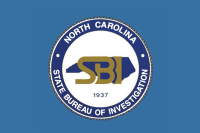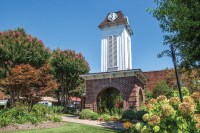Below the waterline: Folkmoot 2016 looks at more than just the tip of the iceberg

Everyone in Western North Carolina knows that once the Smokies shed their winterwear and the trees begin to bud, summer’s coming. They also know that when the dog days hit, the most refreshing thing going is Folkmoot USA’s International Folk Festival.
This year makes the 33rd incarnation of the festival, which germinated from a neighborhood meeting at the home of Dr. Clifton Border in 1983. Now recognized internationally as a top-tier event featuring performances, parades and a whole lotta peace, love and understanding, Folkmoot draws thousands to the region from across the county and across the globe to see and hear the traditions of cultures from around the world displayed through dance and song.
As in years past, this decentralized festival will hold multiple events in multiple locations, from Maggie Valley to Asheville, Canton to Cherokee, Franklin to Hendersonville, Hickory to Lake Junaluska, Bryson City to Waynesville and everywhere in between — meaning Clyde.
Also as in years past, the 26 events featuring hundreds of singers, dancers and musicians will have an economic impact of almost $10 million on the area.
But any successful organization makes minor changes each year to fine-tune operations, and Folkmoot is no different — especially this year, when a smoldering geopolitical climate and simmering domestic unrest conspire to prove that cultural exchanges like Folkmoot are not only relevant but crucial.
Accordingly, this year’s events focus on involving young people and engaging the community.
Related Items
“We moved the Waynesville parade over to Saturday, so working families could attend,” said Angeline Schwab, who is now in her second season as executive director of Folkmoot USA. “That leads in to a brand new event called the Many Cultures Carnival. It’s an outdoor event that’s going to be here on the campus and will have more than 20 non-profits and lots of artist vendors, and a stage featuring young musicians and dances.”
Some of the performing groups will also teach dance lessons, providing more interaction between the dancers and the community.
“That particular event is designed for youth and families, and incorporates engagement but also has performance aspects for the groups,” she said.
Having a place of their own to conduct year-round programming — and house performers — has long been a blessing for Folkmoot; although the organization has been in the 93-year-old former Hazelwood Elementary School building since 2002, they’ve only owned it since 2014.
When purchased, the building was in need of substantial repair, but it has come a long way in recent years with improvements being made to the roof, the auditorium and the multipurpose room.
“Having the building in a continual upgrade state allows us to bring community members into the building in a bigger way, and have events throughout the year. We also have a commercial kitchen and a really nice cafeteria,” said Schwab. “Upgrading the building makes us look better in the eyes of the international community that lives here during Folkmoot, but it also helps us to have community events and community participation that seems to be growing by the month.”
Growing the festival in the coming years is certainly a concern of Schwab’s; other changes in this year’s festival are meant to attract younger audiences and participants.
Kings Mountain native and percussionist Dillon Ingle earned his Bachelor of Science in Music Education from Western Carolina University in 2008. He currently serves as the assistant director of Tuscola High School Band, and this year, he’ll serve as Folkmoot’s musical director, replacing Ann Lough.
“I know he’s been inspiring to my own children because they’re in the band,” Schwab said. “Flora Gammon founded the band and wrote music, and she’s a wonderful Folkmoot supporter and one of the original coordinators of Folkmoot. She was replaced by one of her good friends, Ann Lough, and Ann has other activities she wants to do this summer. Folkmoot is a pretty big commitment, to give up most of June and July. The payback is good, but sometimes, you want to do other things.”
Ingle seems to fit right in with Schwab’s desire for more interesting numbers that retain Gammon’s concepts but integrate some “contemporary flair” by involving local musicians he works with from the schools.
When using the words “local musicians” and “contemporary flair” in Western North Carolina, several other words immediately come to mind: Asheville, and the Orange Peel.
“We have had ‘Late Nighters,’ and let me say that last year was my first event, and it was like a crazy train,” Schwab said of the somewhat-infamous after-hours “cultural exchanges” held until recently in the Folkmoot Friendship Center. “I shouldn’t say that. It was like a peace circus.”
Once the 2015 peace circus was over, Schwab spent hundreds of hours talking to hundreds of people — including the groups — asking them what they really wanted out of the festival.
“What they’re saying is, ‘We love the historical dance, we want to uphold these dance traditions, however, we’d like an opportunity to do contemporary stuff. We’d like the opportunity to have some fun.’ And some of the groups — for instance Chile from last year — said that they were interested in looking at Asheville because it seemed so cosmopolitan, and that’s what they were able to connect to about North Carolina.”
Sprinkled throughout the history of modern American music are a number of notable venues — rock clubs, storied in both their roster of legendary performers, and performances. Those that easily spring to mind are The Whisky a Go Go in Hollywood, the Fillmore West in San Francisco, The Fillmore East and CBGB’s in New York City, Lounge Ax in Chicago and the 40-Watt in Athens, Ga. Among them is Asheville’s Orange Peel.
“We called the Orange Peel, and we have a good friend that works there and owns it,” Schwab said.
As a result, this year a Late-Nighter will be held there and feature a DJ who’s putting together a very special setlist comprised of American and international hits.
“His name is Oso Rey,” she said. “He’s a DJ and an artist who actually composed the painting behind this year’s poster.”
The poster for the July 30 event at the Orange Peel features a brightly-colored, perfectly circular sun peeking out from behind the top of a geometric, angular representation of the top of an iceberg basking in the refracted yellow-orange glow. Warm in tone and overlaid by a chessboard-like grid, the top half stands in stark contrast to the blue-hued largesse of the iceberg that lies below the waterline.
“What you learn at Folkmoot is that we truly are all the same,” Schwab said. “It’s no matter we don’t speak the same languages or share the same religions. We eat different foods and dance different dances but if you’re dancing beside someone, or holding hands with someone in one big circle, you’re not going to hate them. Culture is a huge iceberg. We want to move beyond mere acceptance and help people know about the depth of it.”









